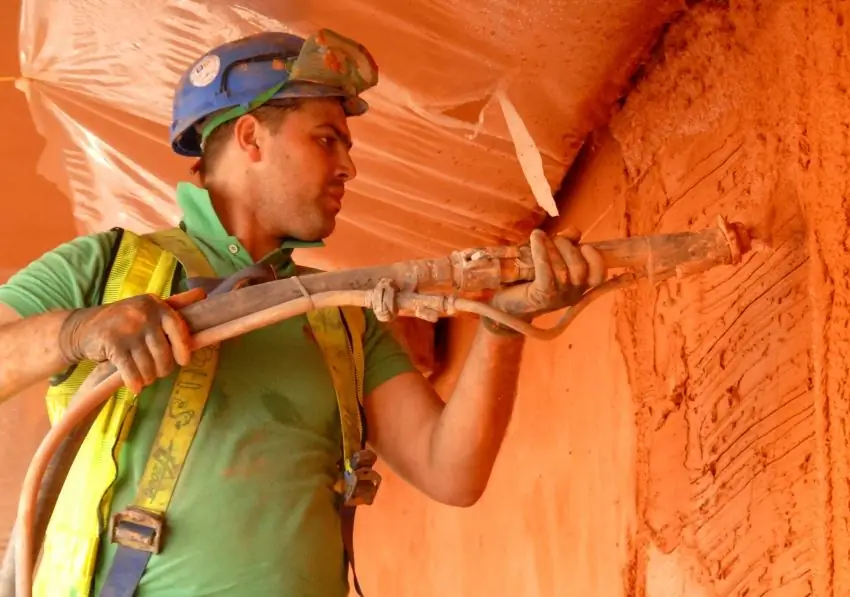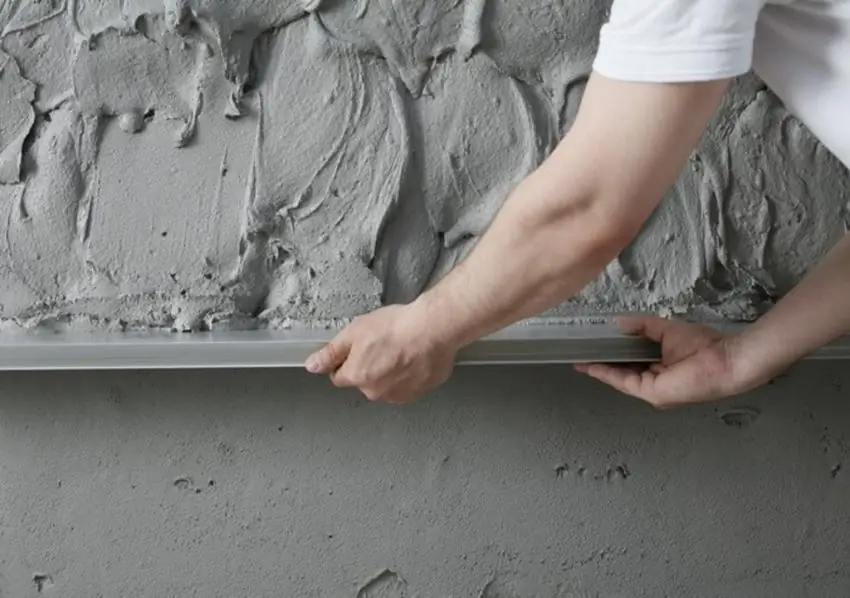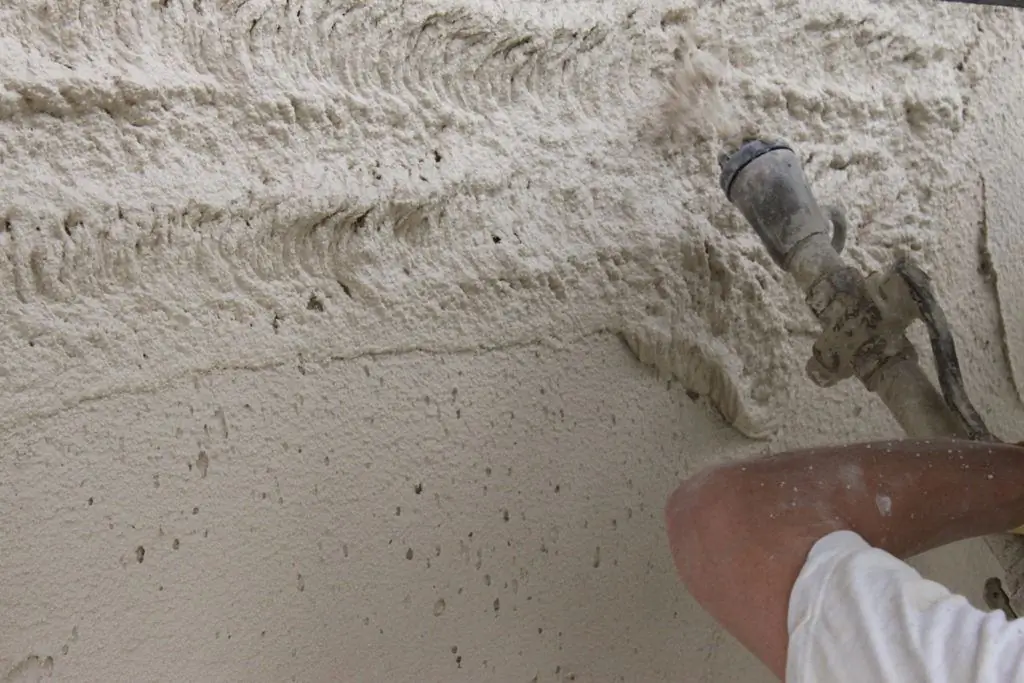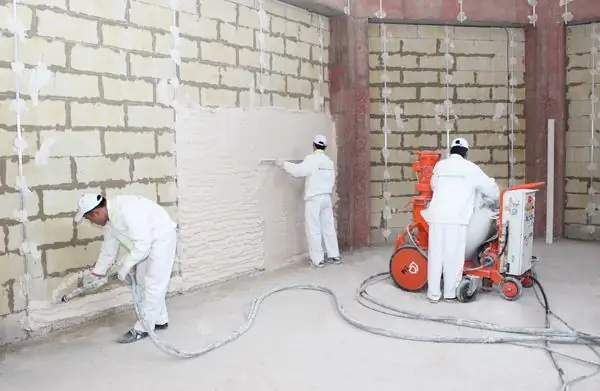One of the main and time-consuming stages of the rough finish of the building is the plastering of the walls. This process takes a very long time, and if specialists are involved in the work, the repair costs will increase by 2 times, which is far from always acceptable. Fortunately, technological progress does not stand still, and today mechanized wall plastering is available to us. The pros and cons, as well as the technology of work, we will consider in this article.
What is the essence of the method?
Mechanical plastering of walls differs from the usual process in that a machine is involved in kneading the working composition and applying it to the wall. A special modular unit prepares the plaster in bulk and delivers it through a hose for application to surfaces.

Using thismethod allows you to perform a rough finish of the room in record time and with minimal effort. There are no special restrictions on the use of modular machines, but it is more expedient to work with them on large objects, for example, inside private houses and in the process of processing building facades.

The mechanized plaster applied to the walls is of high quality, as the machine carefully kneads the solution. The supply of the working composition is carried out through a hose, the length of which allows you to leave the station on the street, and carry out work indoors. This simplifies the supply of dry mix and water to the device.
Advantages of using this method
The advantages of mechanized wall plastering are quite obvious: the machine allows you to create the perfect coating in a short time. However, there are a number of advantages for which it is worth giving preference to the mechanical application of the composition. These include:
- Possibility of using the composition of the same quality. With automatic mixing of plaster, the human factor is completely eliminated. There are no lumps in the solution, the ratio of components is always constant, which makes it possible to avoid deterioration of the properties of the composition as a result of improper mixing.
- Reducing the likelihood of cracks. When applying plaster by hand, the wall is processed in several passes, due to which part of the composition is already drying out and interacts poorly with the new mortar. When using stations, it is possible to cover most of thebase, so that the plaster layer is monolithic.
- Save materials. When evaluating the pros and cons of mechanized wall plastering, one should pay attention to the fact that automatic stirring contributes to the saturation of the composition with oxygen, due to which the mixture is more airy, the consumption of materials is reduced.
The advantages include the fact that the machine-made surface is smoother, which eliminates the need for multi-layer puttying of the walls. This also leads to lower costs.
What are the disadvantages of mechanized wall plastering?
The use of plastering stations does not adversely affect the quality of the work being done. The disadvantages of mechanical application of the composition are manifested in another way. Namely:
- in equipment cost;
- requiring special care for the station;
- noisy equipment operation;
- need to ensure uninterrupted supply of water and electricity.
Purchasing a plastering station is relevant only for large volumes of work. However, in almost every city, such equipment can be rented.
Because the plaster sets quickly, the station must be cleaned frequently or it will quickly fail.

When evaluating the pros and cons of mechanized wall plastering, one should also take into account the fact that the resulting coating has a longer drying period. This is due to the factthat mix manufacturers use special additives to develop the composition before it hardens inside the station.
What compounds are used for plaster machines?
For mechanical application of plaster, special mixtures are used that have the appropriate mark. They are produced both dry and ready-made.
If the work is carried out indoors, preference is given to gypsum compositions. For plastering facades, only cement varieties are used.

As a rule, formulations for automated application are 30% cheaper than analogues for manual work. This can be considered an additional advantage of mechanized plastering.
Work technology
Work begins with the standard preparation of walls for plastering. Surfaces are cleaned of dirt, beacons are installed. Particular attention is paid to preparing the equipment for operation.

Water is supplied to a special compartment and the mixture is poured. Next, the wizard sets the program, which indicates the proportions of the main components. The machine makes the mixture, after which the process of applying the composition begins. It happens like this:
- The master holds the gun at right angles to the wall. The distance between the gun and the wall is 25 cm.
- The mixture is applied from the corner of the room. The gun is moved from bottom to top until the wall is completelywill be covered with plaster.
- The applied mortar is leveled with a wide rule and left to dry. After half an hour, the surface is slightly moistened and smoothed with a grater.
Reviews of the pros and cons of mechanized wall plastering indicate that such a process of applying the composition takes 4 times less time than manual plastering. The master makes a minimum of effort, due to which the quality of work is significantly increased.
Conclusions
The use of plastering stations reduces the time for rough finishing by several times, and the final coating is of high quality. The problem lies only in the high cost of equipment, but after all, each technology has its pros and cons. Mechanized wall plastering is no exception. If the work needs to be carried out in record time, equipment can always be rented or purchased for several construction teams.






